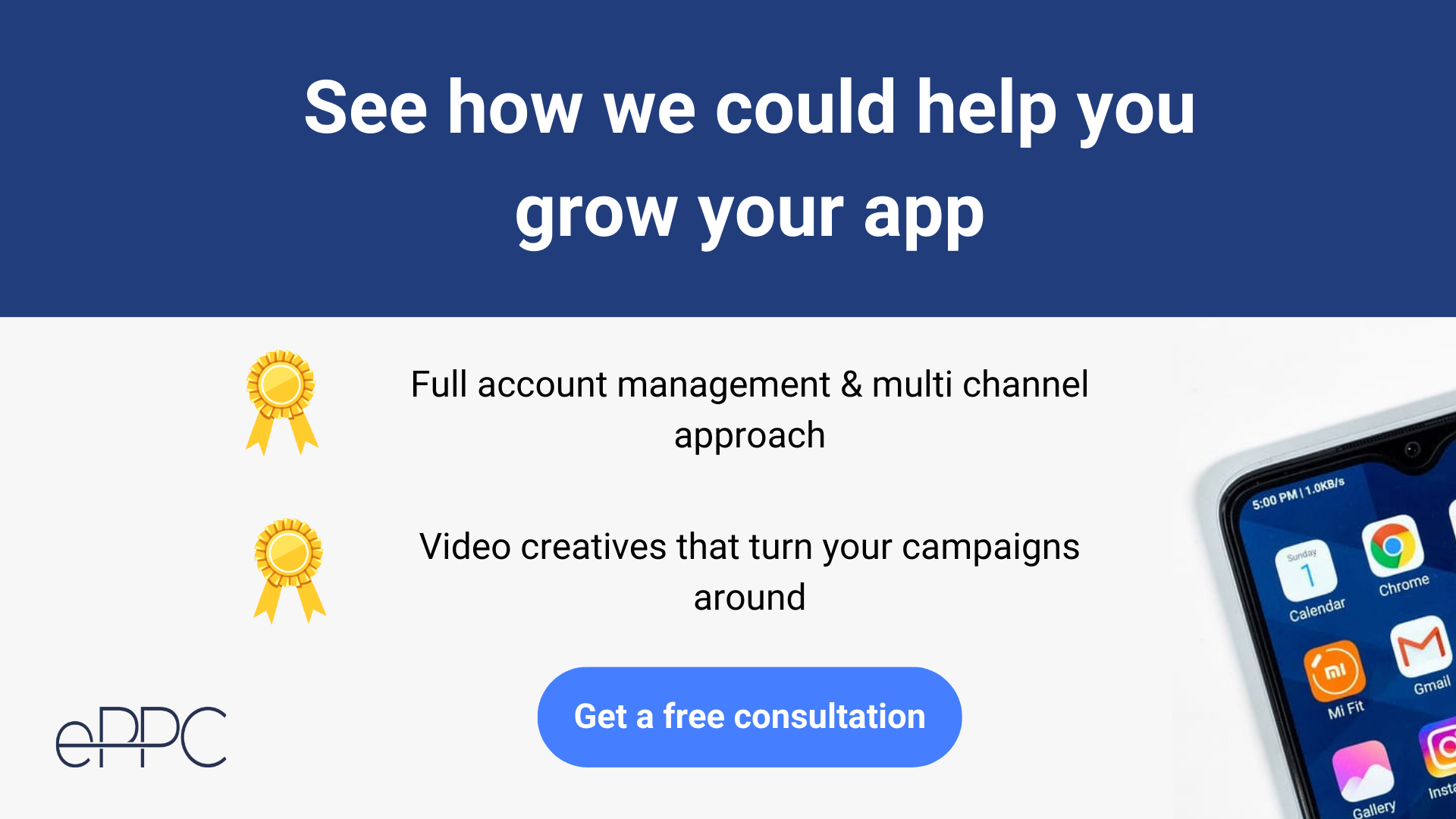How do you go from 10k app installs to a million in one year? How to do it without relying on VC money that enables growth with a negative cash flow? 🤔
We have done it twice in 3 years – First with Synctuition (a meditation app) and now with minimalist phone (an Android productivity app). We managed both of the accounts from start to finish – here’s the story of how we made it happen.
THE STARTING POINT
On both occasions, companies didn’t have massive funds to invest in marketing. What they did have was an awesome product which in combination with great marketing allowed them to grow fast while remaining profitable.
The Synctuition team was ahead of the Spatial Audio trend and provided an incredible eargasmic experience, making it one of the most advanced relaxation apps out there.
Minimalist phone on the other hand helps to tackle a very important issue that affects the majority of us nowadays – how to spend less time on our phones and more on the things that actually matter to us.
Both of the apps had gotten some initial traction but were struggling to find growth.
Here are 5 main factors that helped us reach the goal. Let me know if you would be interested in a longer and more detailed story of the certain points brought out below.
1) Putting a lot of effort into video creatives 🎥
For both apps, we mainly worked with the Google Ads side of the business, so that’s where we directed our focus! From years of experience and domain expertise, we knew those video creatives are the way to unlock growth and acquire higher-quality users with Google App campaigns.
We prioritized videos in the landscape format, as they brought us traffic from YouTube and better ROAS. With Synctuition, we also found that non-landscape videos directed traffic to the display network where the results and the user quality were much worse. In fact, a lot of effort went into manipulating the algorithms in order to get as much traffic from Youtube placements compared to the Display and Search network.
With minimalist phone, we discovered the potential of the Portrait format, which worked amazingly well. Ads on YT shorts were just released and were underused (they still are) by other advertisers and had less competition.
The focus was on making the content very similar to the native content of TikTok (fast-paced, lots of cuts, lower production value, text layover, etc.). We tested lots of different creators, lots of different hooks (getting people to engage with the video within the first seconds is crucial) and finally found the winning creative that helped us scale massively.
Want to copy the formula for the winning ad? Here’s the video with 2.4 million views! 👀
We didn’t stop there. The next step was trying to replicate the success, making educated guesses why this particular ad worked compared to the other ones, etc. The lifetime of a creative in Google ads is much longer than on Facebook or TikTok, but it’s still important to keep on testing and making iterations to find new pockets of audiences to show your ads to.
The difference between approaches for video ads was very different with Synctuition and minimalist phone. Synctuition had videos with a very high production value that are pretty complicated to replicate. Check out the main video with 93M views:
Synctuition videos took a lot of time & money to create, while minimalist phone videos cost around 100-120USD a pop from a single creator.
Looking back on it, Synctuition had a super talented video production and storytelling team that made their videos a success. Without it, the campaigns might have flopped, and the resources to waste.
LESSON SUMMED-UP ✅: Video creative is key for unlocking growth and scale. Use UCG type of videos to test creatives at scale.
2) Understanding the importance of onboarding – being aggressive with monetization while balancing the user experience. 📊
When starting out, minimalist phone was offering a very user-friendly Freemium option (free, but limited version of the full app). We advised being much more aggressive with the paywall and limiting the free version. Martin had many A/B tests to find the best converting option. Every time we went more aggressive with the paywall, the average rating suffered.
Eventually, we found that losing the free option completely had the best impact. The app rating did suffer but stabilized at 4, which is pretty good! We got the rating even higher to 4.2 with good review notification prompts.
Synctuition priced itself as a premium app from the beginning, with a price of around 90 USD per year with a Yearly subscription and a 7-day free trial. The winning formula for them was to ask for a subscription right after the onboarding and then again once they wanted to access locked content.
How do you know which approaches to test? We started generating ideas by looking at the biggest competitors in the space and seeing what they were doing.
LESSON SUMMED-UP ✅: When starting out with testing – be aggressive and make big changes that will have a noticeable impact immediately. Look at the most successful competitors in your app category to get ideas for testing.
3) Having an agile team willing to experiment and implement changes quickly. 👨👩 💻
minimalist phone was pretty much a one-man team – Martin, the founder, was developing the app as a side project next to his full-time job. What I love about Martin is how open he is to experimentation, and how quickly he puts advice into action. This helped us improve the conversion rate from install to trial to payment massively compared to what it was before. Better conversion rates again allowed us to pay more for each install. 📈
Synctuition was similar. The team was always up for experimenting with our suggested ideas and the new product betas coming from Google’s product team – even if some of them weren’t as successful as others.
4) Aiming for a high cashflow, customer LTV & user retention
Advertising platforms are getting more competitive year by year with ad prices and saturation increasing. It’s getting very hard to scale advertising with little cash flow and long payback periods. Without deep pockets, you need that cash flow straight away and can’t afford to have the majority of your clients subscribed to a monthly package.
The teams of Synctuition and minimalist phone realized this pretty quickly. Both managed to get most of their clients to subscribe to a yearly or a lifetime subscription by making the monthly option look less attractive (minimalist) or not offering the option at all while onboarding (Synctuition). However, having only the monthly subscription can be beneficial during the very early stages of the app as this allows you to see better how people churn.
Another way to increase the customer lifetime value (thus allowing us to spend more for the client) was by increasing retention. Having a great product that keeps people coming back is certainly a necessity but there are other valuable actions to commit to as well.
For example, Synctuition’s app consists of different levels, with each level containing 20 unique 25-minute-long sound journeys. They have been releasing new levels every year. This keeps the excitement of fans and helps to retain them.
Having a thought-out strategy for in-app messages and push notifications can help as well! Synctuition’s strategy was to get people to generate a habit of using Synctuition before bed (to clear the mind of negative thoughts and worries before sleep).
LESSON SUMMED-UP ✅: Aim for high cash flow and high customer LTV. Pouring water into a leaking bucket isn’t a sustainable strategy. Fix the leaks before wasting money on scaling
5) Prioritizing revenue over the number of installs 💰
A big mistake marketers make is judging ad networks or campaigns by the CPI (cost per install). There is a big difference between installs coming from different sources (Youtube, Search, Display) and countries. That’s why it was very important for us to get as granular tracking and optimization as possible (evaluating return on ad spend and overall ROI per country with taxes deducted).
When we started with Synctuition, install campaigns brought a better overall CPA and ROAS while having 2x lower CPI. However, as the algorithms improved, the campaign that was optimized for in-app events still got 2x higher CPI but the cost per event and ROAS were much better. Additionally, we had more control when scaling with the tCPA bidding as the campaign would only increase the spend if there was more conversion to be found at a similar CPA.
Another common pitfall for marketers starting out is not understanding how Google’s and Facebook’s algorithms are designed to work and the basics of the auction marketplace’s operations. The algorithms have gotten very efficient at finding users according to the set target.
Do you want to acquire users more likely to make a yearly purchase vs a monthly purchase? You got it (by having correct tracking in place and using tROAS bidding on Android). Would you like to acquire installs at a cheap price? You got it, but don’t expect a good conversion rate (the user quality is secondary because the algorithm delivered its set goal). It isn’t always as simple and straightforward. Sometimes the results can be contradicting. It’s important to keep on testing to find the optimal solution that works for your account.
Unfortunately, tROAS bidding is only available for Android at the moment and iOS advertising hasn’t been the same after iOS 14+ privacy changes – this means that advertisers have to put in a lot more effort to run iOS campaigns efficiently.
LESSON SUMMED-UP ✅: All installs aren’t created equal! Try to evaluate your campaigns as granularly as possible. Use the power of the algorithms to acquire high-quality users.
That’s it! 💪
BTW, we are currently offering free consultations (in a pay-what-you-want model) until the end of the month. So If you’d like to get some insights, then click on the image below, and let’s chat!

